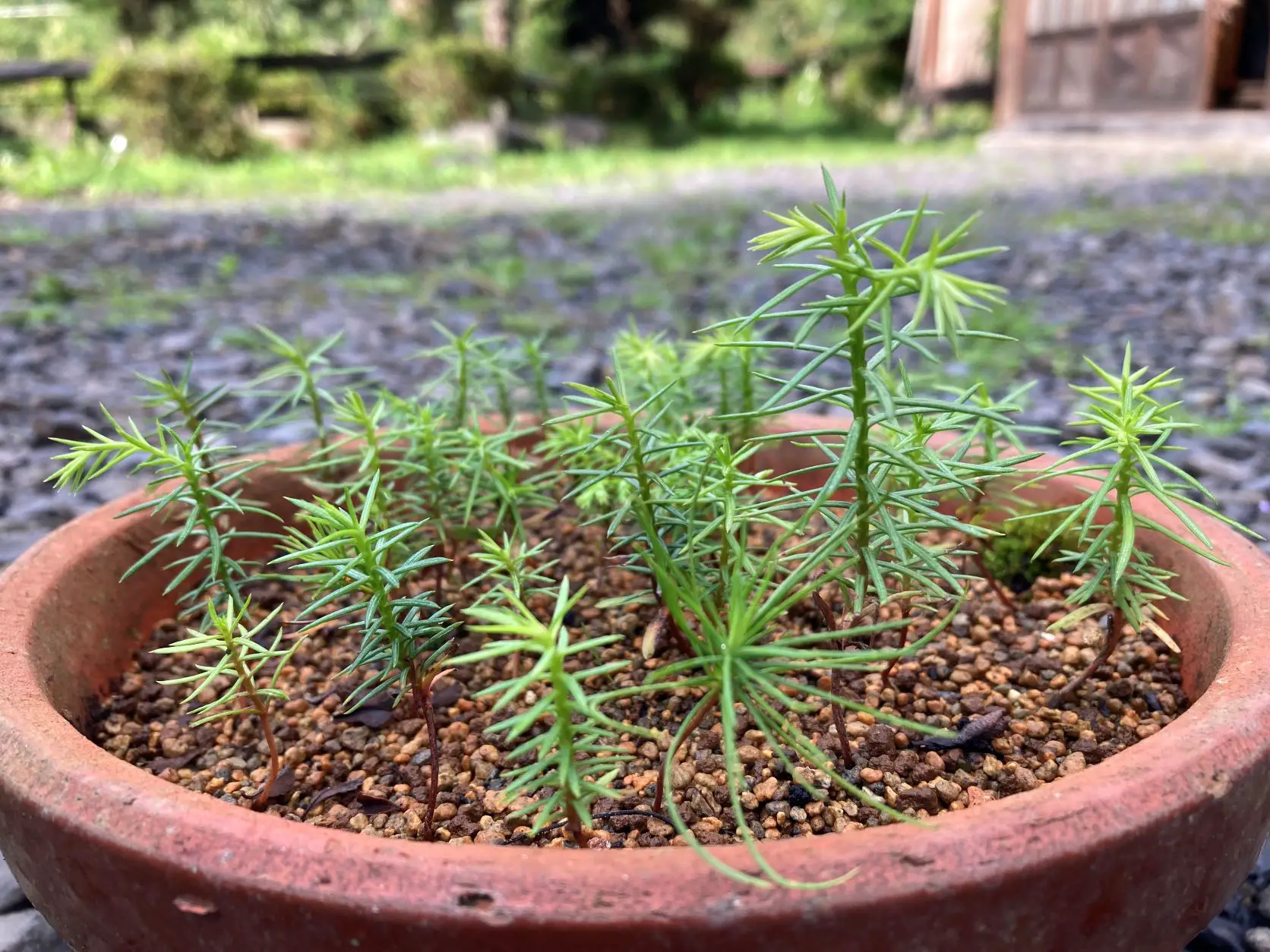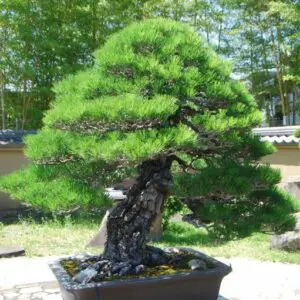How to shape a baby bonsai
The basics
You may think that all seedlings look identical. But if you look closely, each seedling has different characteristics, and no seedlings are the same. It is important to observe their characteristics in detail and choose the right ones for the style you are planning to shape so that you can make the most of their natural looks.
How old should seedlings be before shaping?
Generally speaking, use seedlings that are 3 or more years old. If you are planning to make a mini bonsai, you can start shaping seedlings in the second year after germination.
Remember that the diameter of the trunk grows much faster when the seedlings are left to grow naturally, but the internodes tend to elongate so as the distance to the first branch from the bottom of the trunk (Tachiagari). These are defective characteristics of bonsai trees and are very hard to correct when they are set.
There is not any definitive measure as to how thick the trunk should be before shaping. Generally, the thicker the trunk the better because in nature, old trees have thick trunks and bonsai is aiming to make trees look ancient. But as aforementioned, if you let the seedlings grow naturally, the internodes and Tachiagari tend to elongate. So, the balance between these two is important.
What time of the year to shape the seedlings?
Shaping of the seedlings should be done before summer begins, unlike in the case of mature old bonsai trees; the pruning and shaping are done in early March. Seedlings should be sufficiently fed with nutrients and have strength before shaping. Fertilize the seedlings in fall the year before and in spring until the shaping.
How long to shape the seedlings?
It takes at least 3 to 4 years to shape the seedlings to more or less the desired style. It means that at least 5 years of time is needed for a seedling to become a bonsai tree. You should be looking at a few more years for that “almost bonsai” to be a complete bonsai tree.
Shaping formal upright (Chokkan)
Seedlings that are good for formal upright style
Characteristics in the seedlings you should be looking for to shape in formal upright style (Chokkan) are;
- good Nebari ((surface) roots that spread evenly in every direction),
- straight Tachiagari (the lowest part of the trunk to the first branch from the bottom grows straight),
- upright trunk,
- short internodes,
- branches ramify finely and grow closely together, and
- branches grow alternately around the trunk from left to right and from front to back.
If the leaves are small and beautiful in addition to the above, that seedling is perfect for formal upright style.
That said, seedlings that meet all these conditions are very rare. Choose the ones that meet these conditions in the general sense, not strictly. As far as the shape of the trunk is concerned, it can be straightened by wiring.
To know more about what are good Nebari and Tachiagari, please read the following post.
How to shape the seedlings for formal upright style
How to shape the trunk
When the seedlings are young, their trunk is flexible enough to be straightened in about six months’ time by tying it with a string tightly to a stick (plant support). If you want to use wire, wrap it with a cloth or plastic tube before using it. Make sure to remove the string/wire in fall carefully without damaging the bark.
If the trunk is not straightened enough in fall, repeat the same process the next year. You cannot leave the string attached to the trunk through winter or it may leave a permanent scar on the bark.
How to shape branches
Formal upright style (Chokkan) is a tree shape that is considered to grow smoothly upward. As such, there is not much need for wiring. Wiring is to be done when the branches are growing in an upward direction (which is natural) because branches of young trees grow upward and bonsai does not want that. Branches of an old tree grow downward or horizontally to the ground.
Also, the branches look unbalanced unless they are spread out evenly like the palm of your hand. This should be corrected by wiring as well.
It is important to grow and thicken the first, second, and third branches from the bottom, which form the base of the tree shape. So, pulling down the branches by wiring from an early stage of the growth or picking up the buds that you think you do not need for the shaping may not always be a good idea. Such styling should start gradually after the seedlings have been sufficiently fertilized and gained enough strength.
Having said that, the buds on the top of the tree may need to be pruned off. The trunk will grow vigorously upward and the tree height will stretch if the buds at the top of the trunk are left to grow. In this case, cut the top part of the seedlings to an appropriate height before summer.
Take out unnecessary buds growing from trunks and branches as soon as they appear. For buds that are to be left, pinch off only the tips of overgrown buds to encourage further branching.
Slanting style (Shakan)
Seedlings that are good for slanting style
Characteristics in the seedlings you should be looking for to shape in slanting style are branches leaning to one side, left or right. There are two types of trunks: tilting straight, and tilting while bending at some point. Either one is fine.
How to shape the seedlings for slanting style
Step 1- Preparation
Make sure to fertilize the seedlings well before making the shape. The branches that are pulled down may die off if they are not sufficiently fed and got the strength before bending.
(Surface) roots of seedlings good for slanting style are generally more developed on one side and tend to have more branches on that side. So, it does look very unstable at first glance. But if you plant it with the trunk slanted and the thickest branches pulled down on that side, you get an interesting shape as slanting style.
Step 2
The branches that are to be pulled down are usually the ones grown on the side where the trunk is tilted.
Depending on how the other branches appear, however, it may be better to pull down the branches on the opposite side of the trunk’s tilted direction. In this case, gently twist to the other side the part of the branches that you want to redirect by hand to change the direction of the branch.
Make sure to wrap a piece of cloth for protection around the trunk near the branch before doing it. In addition, put a wire on it so that it stays where you want them to be until it naturally sets.
This rough operation should be performed on seedlings before summer when the sap is in full flow, unlike in the case of mature old bonsai trees.
Step 3
Another important thing for slanting style is to make sure that the front of the trunk stands clearly at an angle. In other words, the diagonal streaks of the trunk must be clearly visible, and the lowered branches must be clearly visible as well. Prune off branches that have grown below the branches that are pulled down.
Step 4
As to the branches that grow above the branches that are pulled down, wire them appropriately and take out the unnecessary buds. Bend each one to make the branches look interesting. The main branches near the lower branches should also be pulled down to the extent that they do not look unnatural.
Semi-cascade style (Kengai)
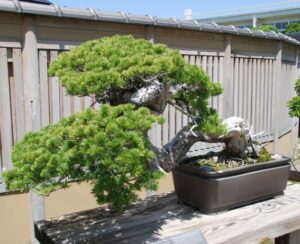
Semi-cascade style
Seedlings that are good for semi-cascade style
Characteristics in the seedlings you should be looking for to shape in semi-cascade style (Kengai) are;
- short height,
- thick trunk,
- short internodes, and
- many branches coming out from the lower part of the trunk.
It is even better if the seedlings have good surface roots and beautiful leaves, and the trunk bends gently near the base of the trunk. On the other hand, seedlings with no lower branches, elongated internodes, thin trunk with few branches are not suitable for this style.
How to shape the seedlings for semi-cascade style
Step 1: preparation
To prepare for semi-cascade style, first, plant the seedling in a medium-deep pot at an angle. This pot defines the shape of the tree because it limits the angle that the trunk is bent to semi-cascade style. The tilting direction can be either left or right.
Step 2: shaping the trunk
The bending of the trunk should be done at the beginning of summer. At this time, it is okay to overdo the bending a little. Even if the trunk splits or cracks slightly, it will heal well without taking too much time.
This bending is done with quite a strong force because you have to bend the trunk that is growing upward to an angle almost touching the ground. So, no matter how young the tree is, it is necessary to refrain from watering for two days before the bending to make them prepared.
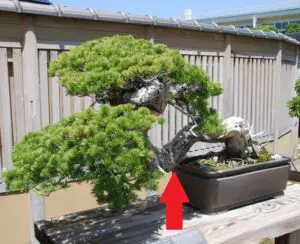
Semi-cascade style (bending point)
The point of bending is where the trunk goes slightly over the rim of the pot as shown in the picture above. This point will depend on the size of the bonsai you plan to make. If you want to make a mini bonsai, bend it about 3.5 inches (9 cm) from the base of the trunk. For a normal size bonsai, it should be somewhere between 6 to 8 inches (15-20 cm). The angle of the bending should be in the shape of frowning lips.
Wrap with cloth or rubber around the part of bending in advance. Put a wire near the bottom of the trunk, and gently and slowly bend it to the desired angle. Then, put a wire around the middle part of the trunk and bend it little by little toward the top. Raise the tip slightly upwards. If the tip of the branch is kept down, the seedling will wither and possibly die.
Step 3: shaping the “head”
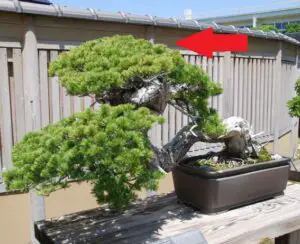
Semi-cascade style (head)
Next, make the shape of the head with the branches that come out from the bottom part of the trunk. It is important to make the head part small enough so that it is aligned next to the branches/foliages that were made into semi-cascade earlier. Again, put a wire on it and bend it little by little to make the branches a “head”.
Make sure not to prune the branches at the same time because it will weaken the seedlings. After 3-4 years, seedlings are generally shaped to the desired style.

